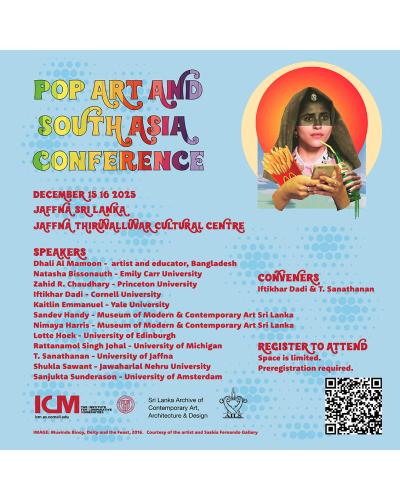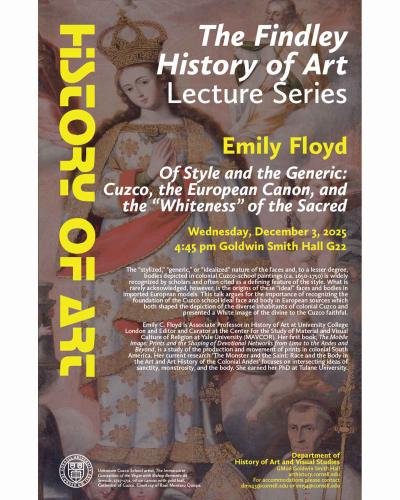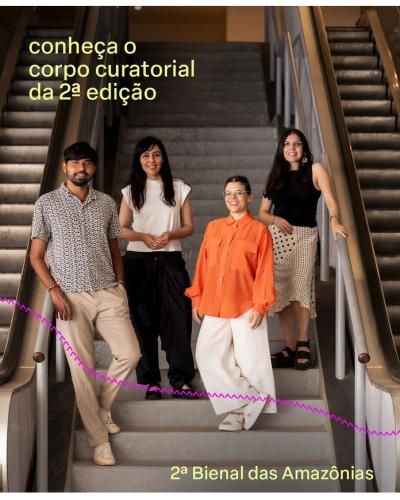SPRING 2022
VISST 2000 Introduction to Visual Studies (AMST 2000/ ARTH 2000/ COML 2000)
J. Rickard
TR 1-2:15
Sections: DIS 201 & 205 R 2:40-3:30, 203 & 207 F 10:10 -11:00, 202 & 206 R 3:45 – 4:35, 204 & 208 F 11:20-12:10
This course introduces the field of Visual Studies. Visual Studies seeks to define and improve our visual relationship to nature and culture after the modern surge in technology and knowledge. It contains objects, images, and problems that lie beyond the Art History and experimental science, yet is grown from both cultures. It teaches the physical and legal limits of human, animal, and machine vision, how knowledge and power get into images, how spectacle drives the economy, and techniques of analysis that can deliver fresh perspectives across disciplines.
ARTH 2355 Introduction to Medieval Art & Culture (MEDVL 2355)
B. Anderson & C. Robinson
TR 2:45-4
Sections: 201 F 1:30 – 2:20 202 F 2:40 – 3:30
Survey lecture course covering the creation, encoding, and reception of Medieval (roughly AD 500-1500) European, Byzantine, and Islamic architecture, ornament, manuscripts, liturgical and luxury objects. The approach is thematic but chronologically grounded; attention is also given to cultural interaction in the Mediterranean basin.
ARTH 3100/6100 History of Photography
A. Moisey
MW 2:45-4
How did photography become the world's most dominant kind of visual representation? This course investigates photography's scientific origins and complex relations to painting, portraiture, urban life, war, anthropology, exploration and travel, and labor and industry. By the 20th century we find photography enriched new developments that include its use as a modernist and experimental art form, in social documentary and photojournalism, in propaganda, in advertising and fashion, and its centrality in the practice of conceptual art, postmodernism, and the art and surveillance of the digital age.
ARTH 3111 Making Photography Matter: A Studio Course (Milstein Course)
A. Moisey
W 9:05-11
By Permission
Photography/Image Analysis/Graphic Design is a hands-on course devoted to the practical understanding of conception, production, and innovation in the photographic image world. Each unit of the course confronts a fundamental problem of contemporary photographic communication—quality of light, framing, series, post-production, publication design, to name a few example topics—from practical, theoretical, and historical perspectives. The goal of the course is to enrich students’ understanding of how to make images that solve practical social and scholarly problems in an impactful, immediate, and public way.
ARTH 3225/6225 Archaic and Classical Greece (ARKEO 3225/ CLASS 3735)
A. Alexandridis
TR 11:25-12:40
This lecture class centers on the formative periods of ancient Greek culture, the centuries from about 800-300 BCE. Its aim is to place Greece within the cosmopolitan networks of the Mediterranean and beyond, while simultaneously looking at specific local traditions. Only within this complex “glocal” frame will it become clear what is unique about Greek art.
In surveying major genres such as architecture, ceramics, sculpture and painting we will also investigate the question of whether and how changing resources and modes of production, various political systems (such as democracy or monarchy) and situations (war, colonization, trade), gender, or theories of representation had an impact on the art of their time. Some of the particular themes to be discussed are: the role of the Near East for the development of Greek visual culture; city planning; images in public and private life; visualizing the human body and the individual; Greek art in contact zones from the Black Sea to Southern Italy and Sicily; “foreign” art in Greece; the concept of art; reception of Greek art in modern times.
Students will acquire “visual literacy” (i.e. the ability to describe, critically interpret and evaluate visual images and material culture in oral and written form). They will learn to reflect upon the pre-conditions of knowledge production and develop criteria to critically evaluate their own work and that of others. In individual and group work they will hone their skills in communicating their thoughts to different audiences.
ARTH 3625/ 6625 Paris, Capital of Modernity?
K. Presutti
MW 9:40- 10:55 am
This course takes a critical perspective on the centrality of Paris to canonical narratives of modernity and modern art and architecture. We will look both at some of the defining art movements of the 19th century and at the influx of people and objects from other cultures—many of whom and which arrived in Paris via colonialist violence and imperialist plunder— that contributed to those movements. Beginning with the French and Haitian Revolutions, moving through Impressionist travels in North Africa and the export of Haussmanization to South America, and ending with Le Corbusier's plan for redesigning Algiers, the course aims to redress some of the silences and oversights written into the history of modern art.
ARTH 3850/6850 The Arts of Southeast Asia (ASIAN 3350/ VISST 3696)
K. McGowan
TR 9:40-10:55
The arts of Southeast Asia are studied in their social context, since in traditional societies creative processes are often mapped on the sequence of events that compose human lives. We will be looking particularly at the gendered ways in which bodies are mapped on the land, and how these various framings are often reflected in the unique relationships that emerge between works of art and textual sources. The South Asian epics of the Ramayana (Story of Rama) and the Mahabharata will be explored during the semester as infinitely renewable sources of inspiration.
4305/ 6305 Looking for Love: Visual and Literary Cultures of Love in the Medieval Mediterranean, 1100 – 1400AD (NES 4795)
C. Robinson
T 12:25-2:20
A comparative and interdisciplinary seminar whose focus is the visual world created by the pan-Mediterranean (Iberian Peninsula, Maghreb, France, Italy, Turkey, Egypt, and Persia) culture of “Courtly Love” beginning during the 11th century AD, and continuing as a principle factor in medieval cultural production for the remainder of the period. Particular attention will be paid to the ways in which the visual dimensions of this culture nuance, compliment, contradict, or at times even exist independently of, its oral and written spheres. Reading knowledge of any Romance or Semitic language and/or Persian, in addition to English, is highly advantageous.
ARTH 4351/6351 Problems in Byzantine Art, Topic: Spiral Relief Columns (ARKEO 4351/ 6351, CLASS 4752/ 7752, MEDVL 4351/ 6351, NES 4351/ 6351, RELST 4351/ 6351, VISST 4351/ 6351)
B. Anderson
T 9:05 -11
In this seminar, we will consider the Roman medium of the spiral relief column (beginning with the Columns of Trajan and Marcus Aurelius) and its reception in Constantinople (the Columns of Theodosius and Arcadius, and perhaps the Joshua Roll) and beyond (the Bernward Column in Hildesheim and the Vendôme Column in Paris, for example).
ARTH 4630/6630 Museum Histories
K. Presutti
W 12:25-2:20
Museum Histories considers current and ongoing crises in arts institutions (COVID, labor issues, underrepresentation of minorities, calls for restitution of wrongfully-acquired objects) in relation to both the history of museums and collections and the kinds of histories they are able to tell. Readings will focus particularly on the 18th and 19th centuries and the ways in which museums developed alongside and in support of nationalist and imperialist agendas, asking to what extent present problems are informed by choices and alignments made in the past. We will also invite curators to discuss how museums can best address the issues covered and how curatorial strategies might address inherent inequalities within our institutions. Students are welcome to do their final projects on an aspect of contemporary museum practice as informed by the history discussed in the seminar.
ARTH 4816/ 6816 Modern Chinese Art (also ASIAN 4473/ 6673, SHUM 4916)
A. Pan
M 9:05-11
China, a cultural giant of East Asia, made a passive entrance into modernity. With the advent of Western and American colonialism and imperialism, coupled with recent successes in westernization by the Japanese, Chinese artists had to redefine their roles as well as their visions. This turmoil bore witness to a vibrant beginning in modern Chinese art. Interactions between the Chinese themselves, and Chinese interactions with foreigners in the major cities of Shanghai and Beijing, fostered new directions in Chinese art and helped shape western visions of Chinese art history. Issues covered include: Chinese debates on western influence–their theoretical foundations and rationales; New visions for the future of Chinese art in the late 19th and early 20th centuries; Pluralistic approaches and arguments on “Chinese identity” in the modern era; Collecting art and the vision of history; The identity of traditional literati painters in the modern era-their roles, artworks, and deeds; Foreigners in China-the formation of major European collections of Chinese art, and the formation of “Chinese art history” in the West.
ARTH 4856/ 6856 Producing Cloth Cultures (VISST 4857)
K. McGowan & A. Alexandridis
W 2:40-4:35
PERMISSION OF INSTRUCTOR REQUIRED
It is a fundamental part of human activity to dress or cover one’s body and environment. While the symbolic significance of such clothing has long been recognized, the activity of producing fabric itself deserves more attention. By this we do not only mean the various techniques and technological devices involved in spinning, weaving, stitching, or sewing, but also the analogical activities and metaphors they entailed. What stories did they tell? How did their connection to writing, remembering, lovemaking, or ruling one’s kingdom, to name but a few examples, play out metaphorically in cloth? And how did fabrics depend on or transform the transmission of techniques, fashions and motives, but also gender, concepts of the body or the built environment?





